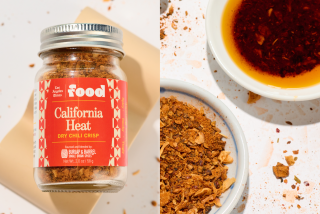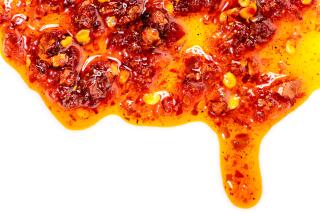The Scoville Dilution
- Share via
Many hot sauce labels boast a digit followed by a string of zeros known as a Scoville rating. It’s a measure of hotness devised by a chemist named Wilbur Lincoln Scoville in 1912.
For the test, a standard quantity of a chile is steeped in alcohol, which is then diluted with thousands of times the same volume of slightly sweetened water. If the majority of a tasting panel can taste hotness when it’s diluted with 10,000 volumes of water, the chile is rated at 10,000 Scoville units.
But the test is notoriously inconsistent. After sipping dozens of samples, you may not be sure you’re getting a burn from the current sample. Also, people differ in their ability to sense the burn--women are about 7% more sensitive to it than men. As a result, you can find jalapen~os rated at 8,000, 12,000 or 20,000.
Modern chemists consider Scoville results nearly meaningless, preferring to measure the physical quantity of the hot stuff in chiles. One reason that gives a better picture is that chiles contain five different hot chemicals, each of which gives a different burn. For instance, capsaicin (the hottest of them), dihydrocapsaicin and nordihydrocapsaicin give a rapid, spicy bite and a pungent sensation in the throat and back of the palate; hydrocapsaicin and homodihydrocapsaicin produce a long, low-intensity bite and pungent sensations in mid-mouth and mid-palate.
By the way, half a dozen synthetic capsaicinoids have been discovered, each with a different burn. One doesn’t burn at all when you consume it--but a couple of minutes later, you start sneezing.
More to Read
Eat your way across L.A.
Get our weekly Tasting Notes newsletter for reviews, news and more.
You may occasionally receive promotional content from the Los Angeles Times.









